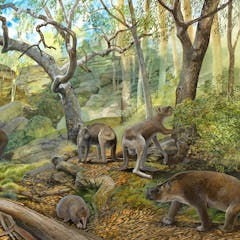
Articles on Megafauna
Displaying 1 - 20 of 72 articles

A recent find of an ancient giant bird’s skull has revealed much about its life among the vanished lakes and wetlands of inland South Australia.

Finding and retrieving the bones of this extinct kangaroo relative – a ‘holy grail’ fossil – took hours of squeezing through narrow passages.

Some extinct kangaroos may barely have hopped at all.

Introduced water buffalo and camels trash native plants – don’t they? Our research shows megafauna herbivores have the same impact wherever they are.

A newly described fossil from South Australia is making waves in our understanding of where and when whales evolved titanic body sizes.

New findings from the La Brea Tar Pits in southern California suggest human-caused wildfires in the region, along with a warming climate, led to the loss of most of the area’s large mammals.

A forensic technique more often used at modern crime scenes identified blood residue from large extinct animals on spearpoints and stone tools used by people who lived in the Carolinas millennia ago.

Having special foot adaptations helped these sizeable animals wander long distances, which meant a better chance to find plentiful food and water.

Africa’s mammals are a global treasure that must be protected.

A puzzle over the identity of an extinct bird that laid eggs across Australia has been solved.

80,000 years ago, Australia’s landscape was dominated by much larger versions of today’s marsupials – including enigmatic and enormous wombats.

Polar bears and wolves may get the glory, but small predators like weasels, foxes and their cousins play outsized ecological roles. And many of these species are declining fast.

Our work provides new evidence against the theory that people living in Sahul drove the megafauna extinction.

The findings will help us better understand how biodiversity responds to a changing climate over time.

A peculiar giant kangaroo that once lived in New Guinea would have descended from a much more ancient form that migrated from Australia, between 5 million and 8 million years ago.

Genyornis newtoni was one of the biggest birds ever to walk the earth. And new research shows its mysterious extinction may have come amid a bout of widespread bone disease as its lake home dried out.

The famous deaths of moas and dodos has fed a narrative in which humans are agents of extinction for island-dwelling animals. But research suggests this only recently became the case.

Incredibly, once the wells dried up some became nurseries for the germination and establishment of wetland trees.

In Gabon’s Lopé National Park, between 1986 and 2018, there’s been a massive collapse in tree fruiting events.

A new study shows Palorchestes had unique elbows unlike any other mammal, which may have contributed to its extinction.
